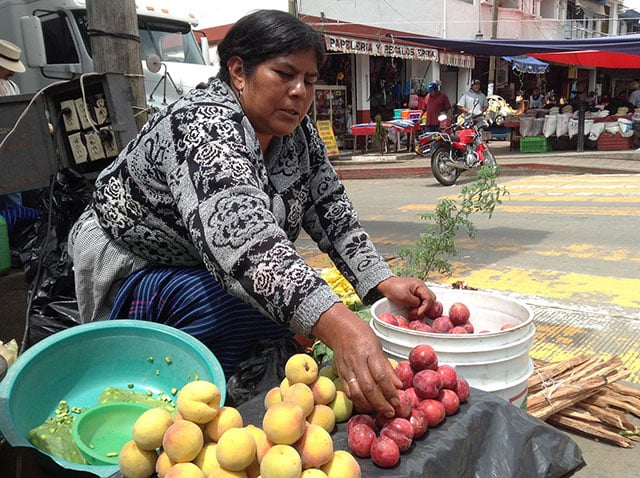
Cherán, Mexico — On a cold and cloudy evening in mid-July, a group of Purépecha Indigenous people gathered in a school patio to participate in a regular community assembly. The noise of playful children and the water hitting the zinc-coated steel sheet covering the patio muffled the conversation between women wrapped in dark-blue shawls and young and old men coming from work at the forest.
The assembly started as a young man read the order of the day. The people expected a detailed, precise, cent-by-cent accounting of the $673,563 budget allocated to public works in a year. The four members of the Consejo de Obras (the Public Works office) must report on every penny spent on closing potholes, paving streets, building walls or any other thing done with public money.
Some of the figures released by the officials didn’t make sense to the audience. A man raised his hand and asked the first of more than a dozen questions on the same topic. He wanted to know why the officials were talking about spending $6,270 on the construction of a stone staircase to the top of the Cerro del Borrego (Sheep’s Hill) when the total cost of the work was $5,405. “Where is the lacking money?” he asked.
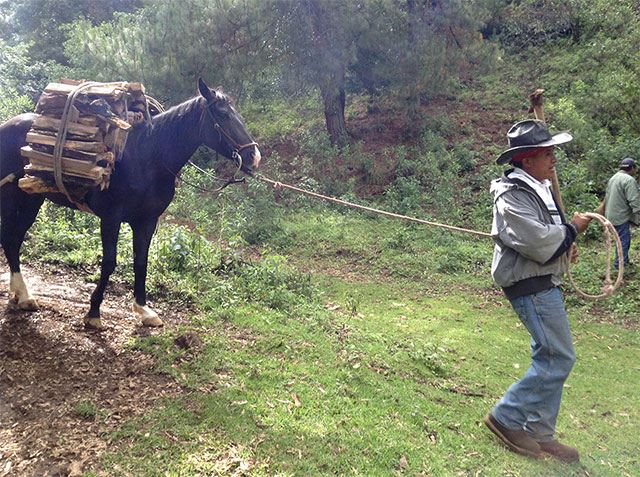 A farmer transports pieces of wood with permission from local authorities. (Photo: Lourdes Cárdenas)
A farmer transports pieces of wood with permission from local authorities. (Photo: Lourdes Cárdenas)
“There is proof for everything,” said Domingo Tapia, a man who, just one year ago, was far away from thinking that his job as a public official from the Consejo de Obras would be so tightly scrutinized by his fellow neighbors and now constituents. “We misplaced some invoices,” he nervously explained.
Bad answer. A woman reprimanded him for giving that kind of excuse.
“We can commit mistakes in many things, but not in the numbers,” she said. “You can’t say we misplaced the papers. We want transparency in the accounts. Next time you come, better bring the real numbers.”
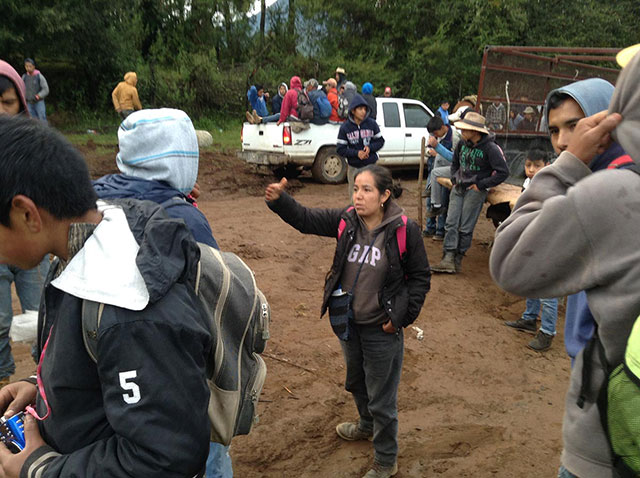 Leticia Medina, a forest technician, talks with one of the reforestation workers. In a regular day, they plant more than 500 little pines in different areas of the forest. (Photo: Lourdes Cárdenas)
Leticia Medina, a forest technician, talks with one of the reforestation workers. In a regular day, they plant more than 500 little pines in different areas of the forest. (Photo: Lourdes Cárdenas)
The people from Cherán seem to be very comfortable with this type of meeting, which was unthinkable five years ago. Like many other Michoacán communities, Cherán was under the yoke of organized crime and extortion. Kidnappings, threats and illegal logging were part of the daily life of this community. Cherán’s residents felt fragile and vulnerable because neither the police, nor their local, state and national authorities were able (or willing) to protect them. But things changed drastically on April 15, 2011, when, armed with stones, sticks and fireworks, the entire community gathered to fight and force out the loggers, who worked for the drug cartels and the public officials allied with them. By doing it, they laid the foundation for a self-determination movement that has reverberated across the country.
At a time when people in diverse areas of the world, including the United States, are very frustrated with politicians, the citizens of Cherán are trying to find their own way apart from traditional institutions. They want to demonstrate that it is possible to build a safer and better society by recovering the Indigenous Purépecha ancestral practices and values and adapting them to modern times.
By no means is it a small merit, considering that Cherán is within a territory controlled by powerful and violent drug cartels: La Familia Michoacana and Los Caballeros Templarios, as well as the Cartel Jalisco Nueva Generacion, which, according to the US Drug Enforcement Administration, is the fastest-growing cartel in Mexico. The state of Michoacán is the main producer of synthetic drugs in Mexico, and an important producer and exporter of marijuana and opium poppies. The cartels have grown and multiplied in spite of a long, costly and bloody war on drugs, partially financed by the United States.
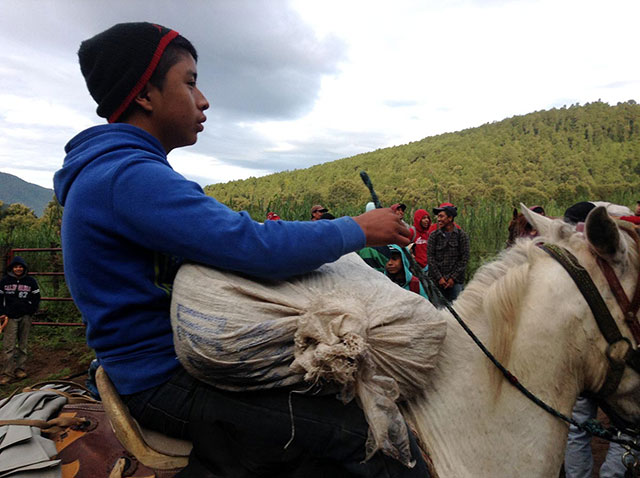 Around 300 people work in the Cheran’s reforestation project during the raining season. Because schools are on vacation, many young boys get temporal jobs for the summer. (Photo: Lourdes Cárdenas)
Around 300 people work in the Cheran’s reforestation project during the raining season. Because schools are on vacation, many young boys get temporal jobs for the summer. (Photo: Lourdes Cárdenas)
Under these circumstances, one wonders how this Indigenous community of 19,000 inhabitants has been able to sustain a successful self-determination movement, and to avoid the interference of drug traffickers and organized crime. What kind of challenges can they face?
“It’s all about communality,” said Pedro Chávez, one of the 12 members of the K’eri Janaskaticha, or the Consejo Mayor, the main governmental body in Cherán. “After living in a situation of uncertainty and insecurity, we hit bottom and we decided to get back to our roots and develop a different way of life, based in communality and respect for our resources.”
It was not an easy fight. It cost them more than 20 lives, extenuating hours of organization and vigilance around the community, and a long legal battle to get official recognition from the federal and state governments.
In Cherán’s unique form of government, the real power lies wholly with the people. There is not a single decision taken without consensus, from who will get a local job in construction, to the allocation of public services and overseeing the spending of the budget. The authority of the community’s assembly is above any other local governmental body.
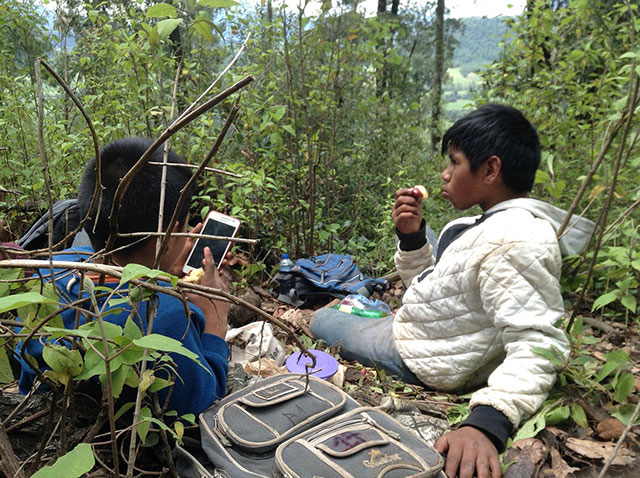 Technology is part of the culture in Cherán too. During lunch time, these boys take a pause to look at their mobile phones. (Photo: Lourdes Cárdenas)
Technology is part of the culture in Cherán too. During lunch time, these boys take a pause to look at their mobile phones. (Photo: Lourdes Cárdenas)
It is a tedious and sometimes bureaucratic process that involves several hours of community assemblies with dozens of redundant interventions, but in the end, the results can be translated in a word: accountability. In a country plagued by corruption and impunity, Cherán is perhaps the only place where that word has a profound and real meaning.
“It can be a tiring process, and sometimes delays important decisions,” said Chávez, a 36-year-old rural teacher and a Ph.D. candidate in popular education. “But in our form of government, the people — the assembly — [are] the [ones] that rule. It is a different form of government, but is working well for us.”
The process of decision-making starts at the block level, where neighbors discuss a topic and take their agreements to the barrio representatives — there are four coordinators in each of the four barrios. They pass the accords to the 12 members of the Consejo Mayor or “K’eris,” a Purépecha word that refers to the oldest and wisest people in the community. In addition, there are eight different consejos, or offices that implement people’s decisions.
 Murals are part of the daily scene in Cherán. Most of them depict moments of the April 2010 movement. (Photo: Lourdes Cárdenas)
Murals are part of the daily scene in Cherán. Most of them depict moments of the April 2010 movement. (Photo: Lourdes Cárdenas)
Every representative is elected in an unusual way: First, the barrios propose the candidates based on their background, capabilities and trust. On election day, people make a line behind the candidate they support, and whoever has the longest line wins the election.
The symbolism of this kind of election is clear: they back up the person who they trust, but in a curious twist, as soon as the person gets into office, that trust often becomes distrust.
“It is a cultural thing, something that we have inherited from the political system,” said Chavez. “The people [have] the idea that political power corrupts, and because of it, they want to be on top of their officials, which I think is very healthy.”
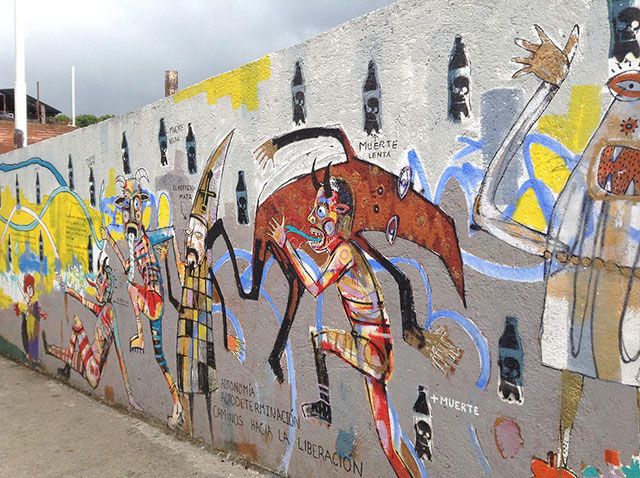 Murals are part of the daily scene in Cherán. Most of them depict moments of the April 2010 movement. (Photo: Lourdes Cárdenas)
Murals are part of the daily scene in Cherán. Most of them depict moments of the April 2010 movement. (Photo: Lourdes Cárdenas)
Cherán’s current achievements match the magnitude of its challenges.
The municipality’s economy essentially rests on forestry exploitation, agriculture, commerce and remittances from migrants living in the US. After losing more than 60 percent of their forest due to illegal logging, their challenge is to make the forest a sustainable source for jobs in the next 10 to 15 years.
“We got to a point where we have social stability and security, but we are not generating jobs for our people,” said Salvador Campos, a businessman who owns a furniture store and is also a member of the Consejo Mayor. “And not having enough jobs makes us vulnerable.”
A Bet of Sustainability
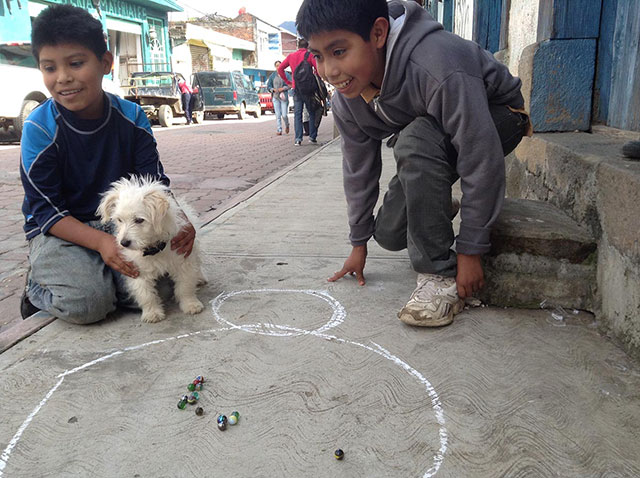 Playing marbles. (Photo: Lourdes Cárdenas)
Playing marbles. (Photo: Lourdes Cárdenas)
There are no convenience stores, no supermarkets in Cherán. Street vending and local commerce prevails. A woman sells one or two chickens in the entrance hall of her house; another one sells giant donuts in a basket; some others sell small quantities of local produce; and in the only hook of a butcher shop hangs just a big chunk of meat. It is a small-scale economy that helps to sustain families and preserve their income.
Cherán has four main community industries: a sawmill, a tree nursery, a resin processor and a rock mine. Until now, none of them were self-sustaining and they mostly worked with federal and state funding. In addition to that, the majority of the jobs they currently provide are temporary. A new water purification plant is providing some jobs for the people too.
One of the main sources of income used to be the sawmill, where the forest’s wood was processed and sold. That was before the illegal loggers devastated more than 60 percent of the 44,000 acres of the forest. After residents expelled the loggers, the community imposed a semi-ban on logging, allowing the cutting only of trees that were old, sick or damaged by natural causes. At the same time, they initiated an ambitious reforestation project. Today, the sawmill works at 20 percent of its capacity and generates less than a dozen jobs, but around 300 people have temporary jobs working on the community nursery and in reforestation. A few more find income collecting and selling resin, which is used in a variety of industries.
But Cherán’s real betting is in the future, when the young and recently planted trees will be tall and healthy enough to make a sustainable living from the forest.
“It is a long-term plan, perhaps 15 to 20 years,” said Angel Chapino, one of the four members of the Consejo de Bienes Comunales, the office in charge of the sawmill, the tree nursery and the resin processing factory. “It’s been five years since our first plantings and we haven’t stopped.”
Leticia Medina Sanchez, 38, is a forest technician who supervises a team of more than 60 workers. Her temporary job starts at 6 a.m. from Monday to Saturday. She and hundreds of men gather around the Bienes Comunales office to sign the attendance sheet before heading to the forest.
Medina organizes her workers in six brigades, each one coordinated by a man. Some of the men carry the root-wrapped tiny trees in sacks or in their backpacks. Others carry the shovels. Many have earphones plugged to their mobile phones, but in no way is it quiet work. Music coming from portable radios also animates the journey.
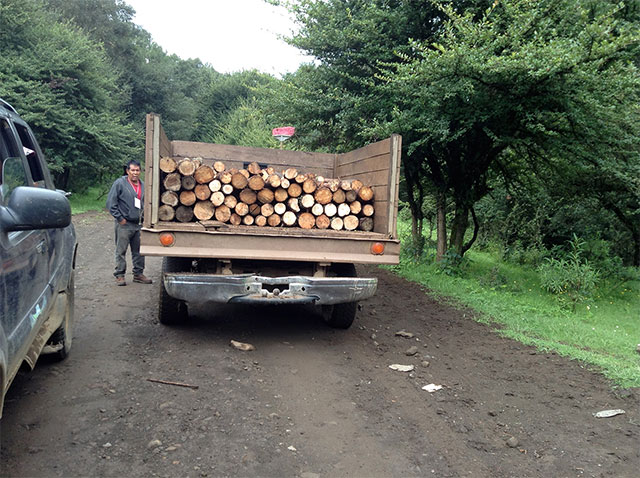 Jose Luis Sanchez is part of the group who patrols the forest every day. He verifies whether the truck driver is permitted to carry wood. (Photo: Lourdes Cárdenas)
Jose Luis Sanchez is part of the group who patrols the forest every day. He verifies whether the truck driver is permitted to carry wood. (Photo: Lourdes Cárdenas)
Medina points out the areas where the baby pines must be planted and the eight-hour journey begins. All of them carry their food in the backpacks — mainly tortillas, guisados, a piece of bread and sodas. Lunchtime has been set at 1 p.m., so they will work five hours before a break. The men work in pairs: one digs a 9- to 10-inch hole, and the other plants the tree using his hands first, and later his foot to compact the soil around it. They repeat this routine more than 50 times on a journey, leaving behind a trail that nourishes hope for the future.
The reforestation project started in 2011 and it’s done during the rainy season. “I think we have done a lot (in five years) — probably we have covered 60 percent of the area, but not everything that has been planted has grown,” Medina said. “Sometimes livestock kills the trees or the workers don’t plant them correctly. Sometimes the plant doesn’t like the soil, and there are plagues too.”
Each of the workers receives a weekly payment of 1,008 pesos, the equivalent of $57. Because neither the sawmill nor the nursery are self-sustaining, the money for the salaries comes from a federal program, which finances the operation of the nursery. The nursery produces around 1.5 million plants per year and the government — through the National Forestry Commission — buys most of the trees. This dependence on the government makes the community vulnerable.
“It is clear for us: If Cherán would move by the logic of its own economy, it wouldn’t be enough,” Chavez said. “We would kill our forest, our natural resources. What we have now is a big number of educated people — our teachers, our migrants — but it is not enough. We need to define how to capitalize our community industries and how to make them sustainable. Right now there is no profit.”
Cherán’s relationship with the federal and state government is not cozy, but at least it’s not as rough as it was at the beginning of the movement, when the conflict reached Mexico’s Supreme Court and was solved in favor of the community. It was a long road that involved lawyers appealing to the constitutional rights of Indigenous communities, as well as international laws and treaties.
As part of the state and federal resources, Cherán receives money to alleviate extreme poverty, to build public infrastructure, to help single mothers and to foster education, among other social programs.
“We have the right to receive state and federal aid, and we get what is earmarked for us, no more, not an additional penny,” Chávez said.
Living in Peace
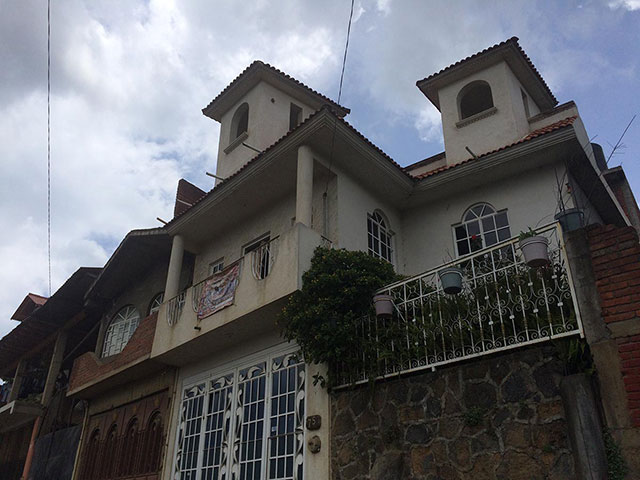 The influence of migration is visible on the two- or three-story houses built on the narrow streets of Cherán. Many of those houses are empty because they owners still reside in the US. (Photo: Lourdes Cárdenas)
The influence of migration is visible on the two- or three-story houses built on the narrow streets of Cherán. Many of those houses are empty because they owners still reside in the US. (Photo: Lourdes Cárdenas)
Cherán’s main crime today is cattle theft. There have been no reports of murder, rape or other violent crimes in the five years of autonomy. However, keeping organized crime away from the community is still a permanent concern and a big challenge.
“[We have to do it] keeping our ronda comunitaria as we have it now, with limitations and lack of resources, but still giving results,” Chávez said.
The ronda comunitaria is one of the cornerstones of the movement. It is composed of volunteers — ordinary citizens, with no previous police experience — who patrol the forest and the streets every day. They also monitor the main town’s entry points. Every stranger coming into Cherán passes a checkpoint. If something is wrong, they communicate by radio and the entire town goes on alert. Their members don’t have sophisticated training, but they have permits to carry weapons.
The ronda comunitaria has been a constant point of tension with the state authorities that want it to be part of the unique state police force. The state government argues that a unified police force is crucial to fight organized crime and to have professional and well-trained officers. But for the residents of Cherán, that is not a negotiable issue. Because of their previous experience, they are absolutely convinced that being part of the state police wouldn’t help to keep the community safer.
“The determination of our movement is self-protection,” said Chávez “When we were threatened by organized crime, the government didn’t pay attention to us, and now they want to co-opt us and intervene…. To be part of the unique state police force will make us lose our autonomy.”
People in Cherán are aware that things are not easy and won’t be anytime soon.
“It is not easy to reconstitute our territory and to repair the damage that was made to our forest,” says Chávez. “But we have decided to take care of our plants, our water, our ecosystem because there is the future of our community.”
Press freedom is under attack
As Trump cracks down on political speech, independent media is increasingly necessary.
Truthout produces reporting you won’t see in the mainstream: journalism from the frontlines of global conflict, interviews with grassroots movement leaders, high-quality legal analysis and more.
Our work is possible thanks to reader support. Help Truthout catalyze change and social justice — make a tax-deductible monthly or one-time donation today.